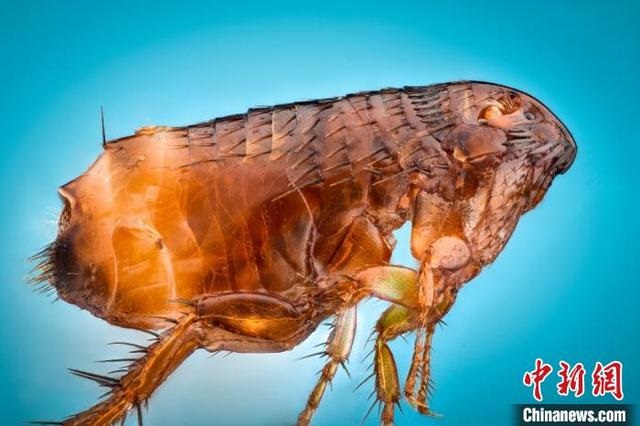媒体关注
-
【科技日报】系统发育基因组学 让跳蚤认祖归宗蚤目(俗称跳蚤)是一种令人讨厌的生物,但是科学家对它却非常感兴趣,因为跳蚤与其它昆虫目之间的亲缘关系,一直是昆虫系统学领域的未解之谜。12月25日,记者从中国科学院南京地质古生物研究所获悉,该所与英国科研团队合作,通过对开源组学数据的挖掘和深入系统发育基因组学分析,揭示跳蚤是一类特化的蝎蛉,相关研究成果发表于《古昆虫学》。跳蚤属于节肢动物门、昆虫纲,是一类体型侧扁,外形高度特化,并严格以吸血为生的全变态昆虫。跳蚤体型很小,通常体长1—3毫米。它是外寄生昆虫,吸食哺乳动物(包括人类)和鸟类的血液。中国科学院南京地质古生物研究所蔡晨阳、黄迪颖研究团队和英国布里斯托大学古生物团队合作,选取了现生吸吻类26个代表物种,包括长翅目所有亚目、蚤目和双翅目,并根据此前千种昆虫转录组进化团队测得的转录组数据,调取了1478个直系同源单拷贝蛋白编码核基因,这代表着目前已知最大的吸吻类分子数据矩阵。此外,研究人员还构建了包括29个物种的线粒体基因组与多个基因联合的较小数据矩阵。所有研究结果表明,蚤目位于长翅目的内部,与现生的小蝎蛉科构成姊妹群的关系。在形态特征方面,蚤目与现生小蝎蛉科具有潜在的共有衍征,如口器特征和精泵。现生小蝎蛉口器较特化,具有由上唇形成的食物通道和针状上颚等,与吸食植物流汁相适应,而中生代的阿纽蝎蛉恰好填补了小蝎蛉科向跳蚤过渡的演化缺失环节。研究证明了跳蚤是从吸食植物花蜜的长翅目祖先演化而来,最终成为如今吸食脊椎动物血液的寄生虫。系统发育基因组学的结果也为当今昆虫系统分类提供了重要的参考依据。根据跳蚤位于长翅目内部的系统发育关系,研究人员正式提出蚤目应降级为蚤次目(infraorder)。现生完全变态类昆虫将从11个目减少为10个目,这项研究成果将对现生昆虫系统分类体系具有深远的影响。2021-01-04
-
-
-
【澎湃新闻】跳蚤“认祖归宗”地位“下降”:跳蚤的祖先找到了,不吸血!科学澄清误解。白蚁其实是特殊的蟑螂,虱子其实是啮虫,鸟其实是一类特化的恐龙,恐龙没有灭绝!“而跳蚤其实是一类特化的蝎蛉,其祖先不吸血!”12月21日最新发表在《古昆虫学》(Palaeoentomology)上的一篇研究论文显示,跳蚤是从吸食植物花蜜的长翅目祖先演化而来,最终成为如今吸食动物血液的寄生虫。蝎蛉是长翅目昆虫的总称,成虫具有两对狭长的翅,现生大多在森林、峡谷或植被茂密的地区,多取食死亡的软体昆虫,捕食各种昆虫,或取食苔藓类植物。 蝎蛉。受访者供图该研究由中国科学院南京地质古生物研究所蔡晨阳、黄迪颖研究团队和英国布里斯托大学古生物团队合作完成。研究人员正式提出,在“界门纲目科属种”分类学上,将跳蚤所属的蚤目降级为蚤次目(infraorder)。换句话说,跳蚤的分类学地位“下降”了。现生完全变态类昆虫将从11个目减少为10个目。这项研究成果将对现生昆虫系统分类体系具有深远的影响。 跳蚤。蔡晨阳告诉澎湃新闻(www.thepaper.cn),目前大约有2500种跳蚤,最大的个体体长约3-4毫米。跳蚤因为传播黑死病,引起巨大疫情,造成大量人员死亡,跳蚤曾改变人类的发展进程。这一最新发表的研究结果让人们明白,跳蚤的祖先不是吸血的,而很可能是吸食植物汁液,它们寄生的对象从最初的植物,到哺乳动物,再到人。该论文显示,系统发育基因组学的结果显示,蚤目与现生的小蝎蛉科构成姊妹群的关系,蚤目位于长翅目的内部,完全否定跳蚤与雪蝎蛉科、跳蚤与双翅目之间的姊妹群关系。以上结果是根据目前已知最大的吸吻类(包括跳蚤、蝎龄、苍蝇、蚊子等)分子数据矩阵,以及29个物种的线粒体基因组与多个基因联合的较小的数据矩阵进行研究得出。 系统发育基因组学揭示跳蚤与小蝎蛉科构成姊妹群的关系。跳蚤(Siphonaptera,黄色),小蝎蛉(Nannochorista,绿色)。在形态特征方面,蚤目与现生小蝎蛉科具有潜在的共有衍征,如口器特征和精泵。相关研究工作由中国科学院、国家自然科学基金委和英国皇家学会的资助。2012年初,中国科学家发现亿年前的巨型跳蚤化石,其体长达两厘米。其很长的刺吸式口器显示了与中生代具长喙的阿纽蝎蛉科的相似性。后者可能是的裸子植物的传粉者。该研究由中国科学院南京地质古生物研究所黄迪颖研究团队完成,发表在《自然》(Nature)杂志上,化石产自我国内蒙宁城中侏罗世道虎沟动物群(距今约1.65亿年)和辽宁北票早白垩世热河动物群(约1.25亿年)。2020年初,中国科学院南京地质古生物研究所王博研究团队在《科学进展》(ScienceAdvances)杂志报道了白垩纪缅甸琥珀中具长喙的阿纽蝎蛉化石。中生代的阿纽蝎蛉恰好填补了小蝎蛉科向跳蚤过渡的演化缺失环节。2020-12-22
-
【中新网】科学家最新研究发现跳蚤是特化的蝎蛉中新网南京12月21日电(徐珊珊)据中国科学院南京地质古生物研究所21日消息,由中英联合的研究团队近日揭示了跳蚤是一类特化的蝎蛉,将蚤目降级为长翅目的一个次目。相关研究成果于2020年12月21日发表于《古昆虫学》(Palaeoentomology)。蚤目(俗称跳蚤)属于节肢动物门、昆虫纲,是一类体型侧扁,外形高度特化,并严格以吸血为生的全变态昆虫。跳蚤体型很小,通常体长1—3毫米。跳蚤是外寄生昆虫,吸食哺乳动物(包括人类)和鸟类的血液。蚤目作为昆虫系统演化树上一个独立的分支,得到了许多形态特征(侧扁、无翅、具刺吸式口器、具栉等)和生活习性等证据的支持。然而,跳蚤与其他昆虫目之间的亲缘关系一直是昆虫系统学领域的未解之谜。21世纪以来,随着分子系统学和基因组测序技术的发展,跳蚤系统位置的难题并没有得到解决。2020年初,南京地质古生物研究所王博研究团队在《科学进展》(ScienceAdvances)杂志报道了白垩纪缅甸琥珀中具长喙的阿纽蝎蛉化石。通过对38个化石类群的54个形态特征的系统发育分析,表明长翅目是多系群,蚤目与双翅目构成姊妹群;并认为阿纽蝎蛉的口器与跳蚤不同,不是蚤目的姊妹群。尽管跳蚤系统位置的研究对理解寄生性行为的起源和昆虫分类体系的确立具有重要的意义,但相关系统学研究进展缓慢。科研人员近日通过对开源组学数据的挖掘和深入系统发育基因组学分析,确立了吸吻类(长翅目、蚤目和双翅目)内部的系统发育关系,揭示跳蚤是一类特化的蝎蛉,并将蚤目降级为长翅目的一个次目。中国科学院南京地质古生物研究所蔡晨阳、黄迪颖研究团队和英国布里斯托大学古生物团队合作,选取了现生吸吻类26个代表物种,包括长翅目所有亚目、蚤目和双翅目,并根据此前千种昆虫转录组进化(1KITE)团队测得的转录组数据,调取了1478个直系同源单拷贝蛋白编码核基因。研究人员利用3种不同的氨基酸进化模型对3个矩阵进行了贝叶斯推演和最大似然分析来构建系统树。所有结果一致表明吸吻类的单系性,并证明蚤目位于长翅目的内部,与现生的小蝎蛉科构成姊妹群的关系。据介绍,系统发育基因组学的结果也为当今昆虫系统分类提供重要的参考依据。根据跳蚤位于长翅目内部的系统发育关系,研究人员正式提出蚤目应降级为蚤次目。现生完全变态类昆虫将从11个目减少为10个目,这项研究成果将对现生昆虫系统分类体系具有深远的影响。(完)2020-12-22
-
-
【文汇网】挺进无人区,探寻青藏高原演化奥秘日期:2020年12月13日07:31:32作者:付鑫鑫 ▲袁东勋在文布乡北村一处剖面采集牙形化石,这是此行科考中坡度最陡的一座山。 今年8月底至10月初,中国科学院南京地质古生物研究所(以下简称南古所)、南京大学等单位派员组成的第二次青藏高原综合科学考察研究南京地层古生物科考分队,奔赴西藏藏北无人区开展科考。 中国境内的青藏高原,占我国陆地面积的26%。作为地球上保存最完整的造山带,这里岩石出露良好,是科学家研究地球动力学的天然实验室。 上世纪70年代,中国科学院院士、中国科学院地理科学与资源研究所孙鸿烈研究员组织并领导第一次青藏综合科学考察,发现了上百种新物种,填补了青藏高原一些地区和学科研究的空白。 南古所是目前我国唯一从事古生物学和地层学研究的专业机构,是国际三大古生物研究中心之一。截至目前,我国确立的11颗“金钉子”(全球年代地层单位界线层型剖面和点位)中,南古所主持确立了7枚,参与确立了2枚。 “青藏高原对地层古生物,甚至对整个地球科学来讲,它都是一部天书。”科考分队领队、南古所研究员张以春坦言,“遥远的地质历史时期,生物如何进化、环境如何演变,其中答案将为现今生物与环境的相互关系研究提供些微帮助。” 金秋时节,热觉茶卡,海拔4800米,晴空万里。科考分队副领队、南古所研究员张华吩咐大家轮流挖探槽,寻取比较新鲜的露头,因为地表覆盖的是风化的浮土,看不到原始地层信息。挖探槽2小时后,南古所副研究员郑全锋说:“太累了!在这里挖一下,可能相当于在平地挖10下,高原缺氧。”“火山灰靠你了。”南古所副研究员郄文昆和罗茂开玩笑。“靠我了你把我变成火山灰!”罗茂快人快语。“先放地幔里融一融。”郄文昆说。“那出来是岩浆岩。”队友纠正。“岩浆岩喷出来就是火山灰。”郄文昆答。此时此刻,冰饮料、大西瓜成了科考队员们最想念的“奢侈品”。又过了近2个小时,众人感叹,干体力活的时间过得好慢。“不知道的,肯定以为我们在挖金子。”郑全锋自嘲。挖探槽5个小时后,张以春在别处采了8袋有孔虫化石、20多袋牙形化石,与众人汇合。临走时,大伙商量锤子的归处:“要不就埋这吧,明天还来呢。”“锤子不要落下。”“锤子就是我的生命。” ▲张以春记录剖面信息。 的确,对于地质工作者来说,地质锤、罗盘和放大镜是必备的三大件。张以春带的放大镜是十几年前从母校带来的迷你放大镜,仅纽扣大小,“现在的放大镜镜片太厚,我这个比较薄、轻便”。除了三大件,队员的行李箱里各有“法宝”:郑全锋带了护膝和可折叠椅,他的膝盖有伤,又要在野外赶论文;罗茂带了一套正装,中途得去北京答辩;助理研究员袁东勋有低血糖,带了一包薄荷糖,外加一件钓鱼马甲——口袋多,方便出工时带更多的化石样品袋……张以春说自己是个喜欢计划的人,一年前就开始准备了。这是他第17次进藏,队伍规模最大,共25人。 泥盆纪“海洋霸主”邓氏鱼,可以吃掉鲨鱼 刚到拉萨,罗茂的高原反应比较厉害。“我浑身发热,盖着被子,又不敢蹬掉,感冒更麻烦。”发了两天的汗,他很快适应了。记者问,第一次进藏不会害怕吗罗茂说,大多数地球科学工作者都很向往青藏高原。“我的研究方向是,地球历史上生物大灭绝后的生态系复苏过程,即2.52亿年前到2.47亿年前,哪些因素引发了生物复苏。青藏高原记录了这些变化,一直很想去走一遭。”南古所研究生琚琦是此次科考团队里唯一的女生。她告诉记者:“对高反没有心理负担,但条件比想象的艰苦。早上八九点出去采样,下午四五点回营地,中午吃的都是馒头、鸡蛋和榨菜,能吃上辣条就很幸福了。露营睡帐篷,大风响得好像在耳边打机关枪,沙子又多,睡不踏实。一个多月下来,每个人都又黑又瘦,张老师都瘦了十几斤。”对于“掉肉”,张以春不以为然。上世纪70年代,老一辈科学家进藏科考,到处都是陷车的路,采样得靠牦牛驮出来装车。如今西藏“村村通”,到处是柏油路。“我们寄回来有3吨化石和岩石。现在采样前,自己可以先不爬山,用无人机飞上去看看。”张以春至今还记得,2001年第一次进藏科考,足足失联114天,“到了日喀则,我都不好意思进城,浑身上下就是个‘泥人’,怕影响市容。”说完,他和记者同时笑了起来。从拉萨往北,翻过5190米的那根拉山口,抵达海拔4700米的班戈县适应两天,团队继续向北进发,抵达藏北无人区,正式开工——沿着地质图的指引搜索地层剖面,探寻2.5亿年前生物大灭绝时期,即二叠系和三叠系界线处的地质记录。 ▲当惹雍错二叠系剖面中的珊瑚化石 在玛依岗日地区,张以春第一眼就发现了晚二叠世的柯兰尼氏虫化石。他的研究方向是二叠纪(距今约2.99亿年至2.5亿年)的有孔虫化石及古生物地理,必须采集块状的化石,不能采碎样。“有孔虫化石是微体化石,需要后期切块、打磨。比如,有的有孔虫很小,几毫米到几厘米,对切片技术要求高,切过中轴才有用。”在办公室,张以春转头从显微镜边上的小盒子里取出透明玻璃片展示:“这种算是大的了,半径有1厘米。有的有孔虫只有几微米。”记者盯着玻璃上薄如蝉翼的石头切片,肉眼可见纹路清晰如指纹,最外一圈特别厚实,那便是圆形的有孔虫。随后,他又展示了条状的有孔虫,仿若微型的手指饼。除了有孔虫,玛依岗日地区还有植物化石。这次,主攻二叠纪末生物大灭绝环境背景的张华,在工作点附近找到了异常丰富的栉羊齿、单网羊齿等大羽羊齿植物,这些植物在2.5亿年前也生活在赤道附近的热带雨林中。更为直观的发现是,研究沉积学的郑全锋找到了二叠纪晚期的煤——2.5亿年前,海平面快速上升,大量高等植物被淹没、埋藏形成了腐殖煤。 ▲玛依岗日雪山旁的奥陶纪角石化石 驱车途中,科考队在无人区偶遇三头散开的野牦牛。郄文昆有望远镜,看见野牦牛很兴奋,“当时,野牦牛在我们车队的右前方,不能靠得太近。张以春老师说过,单只的野牦牛很可怕,可以轻松撞翻一台车,我们远远地看了看,个头真挺大。”“我们也碰到一只野牦牛,开始没注意,后来看见了,最近大概距离150米,赶紧调转车头就往回跑。”罗茂补充说。在泥盆纪点位,研究泥盆纪古生物和古生态的郄文昆介绍说,泥盆纪距今约4.2亿年到3.59亿年,被称为“鱼类的时代”,各种类群的鱼已经出现,比如,“海洋中的霸主”邓氏鱼是当时的主要鱼类,甚至可以吃掉鲨鱼。 ▲琚琦在剖面工作。张以春摄 泥上留指爪是古人所见,遗迹化石可以将今论古 在海拔4850米的藏北无人区,罗茂发现了一块遗迹化石,上面有树枝状的凸出痕迹,初步看疑似海星停歇迹的化石。遗迹化石可以用来推断沉积环境,研究早期生命演化。在地质历史时期,有钙质骨骼的生物较易保存,软体动物则很难保存在化石记录里,科学家可以通过观察它们的遗迹,来理解和恢复这些生物的生态特征。比如,螃蟹、虾等节肢动物滑过泥土表面,就会形成遗迹。罗茂由此想到,古人对生物遗迹也有过细致描述。宋代文学家苏轼在《和子由渑池怀旧》中写道:“人生到处知何似,应似飞鸿踏雪泥。泥上偶然留指爪,鸿飞那复计东西。”说的是飞鸟在雪地、泥土上留下了痕迹。“我们做遗迹化石,有句行话叫‘将今论古’,意思是现在发生的事情在古代同样发生过。”罗茂接受采访时,将办公室架子上一盘盘的粪便化石郑重地端出来,“其中有部分是我从藏北无人区捡来的草狐狸、狼的粪便。”研究这些已知的现代高原动物粪便,有助解读古代粪化石中的生态信息,包括食谱等。 ▲蕉叶贝类腕足化石 “以‘屎’为鉴,可以知生态。”听上去是句玩笑,却蕴含真理。在罗茂看来,粪便化石是遗迹化石中非常特殊又重要的化石,可以用于解读地史时期生态系统中,各种生物之间的复杂关系,尤其是捕食者与被捕食者间的生态关系。“这块化石里有骨头,还有毛发,可见是生物链比较顶端的物种。这次,我捡回来有一块特别大的,很可能就是棕熊的粪便化石。”即使被人误解为挖捡石头的、找矿的,科学家们依然无怨无悔地工作着。张以春说:“在青藏高原,背五六十斤化石下山,很喘很辛苦,但这些都是正常工作,了解地球、做自己喜欢的事,特幸福。地球上几十亿人,研究地球科学的人只是极少数,成为其中一员深感荣幸。”在西藏那曲市尼玛县荣玛乡北部,张以春发现了角石动物(鹦鹉螺)化石——一种与河蚌同类型的软体动物,生活在约4.5亿年前的海洋,是当时的海洋霸主,捕食能力超强。指着化石上像笋尖的一条白色痕迹,他解释道:“这个尖头是它的壳,因为它是软体动物,像章鱼一样吸食食物。与白色垂直的黑线叫隔壁,隔壁与隔壁之间被称为房室。最后没有隔壁的地方应该是它的软体部分。角石主要生活在奥陶纪,体内有体管,可以连接每个房室。”花岗岩是地质学上比较好断代的标识物。在冈塘错湖附近,团队遇到了一座特别的山,山峰由多个凸起的山尖组成,连绵不绝。据介绍,这座山全部由2.22亿年到2.14亿年前的花岗岩组成。当时,古特提斯洋壳已经俯冲到北羌塘地壳下,并发生断离,大量岩浆上涌,形成了这些花岗岩。由此证明,在2.11亿年前,南羌塘地块和北羌塘地块已经完成碰撞。 揭示地球历史真相,吃再多的苦也甘之如饴 在尼玛县文布乡北村附近,为寻找海拔4960米山顶的灰岩,张华带队垂直攀爬了近300米,踏勘的是晚古生代大冰期结束后的灰岩沉积。大冰期结束后,海平面即将上升,这个地层剖面从底下的拉嘎组冰碛岩,到上面的昂杰组,再到下拉组,没有错动,是一套从碎屑岩到红色灰岩的完整沉积,时间跨度1000多万年,体现了早二叠到中二叠,冰室气候向温室气候转变的一个过渡。 ▲二叠纪腕足类化石 在这个科考点,郑全锋发现了晚古生代大冰期快要结束阶段形成的冰海沉积岩,其中既有冰川底部融出的岩块落入水中而形成的坠石构造,又有海相的腕足化石。这些冰海沉积岩是地球历史上存在冰期(地球南北极中两极或一极有冰盖)的直接证据。地球现在约46亿岁,经历了5个大冰期,目前仍处于第四纪冰期当中。“为了做好文布乡的北村剖面,我在那连续工作了4天。山脚海拔大约4700米,山顶4960米,山坡很陡,接近50度,非常难爬,是我干过最艰苦的剖面。但这个剖面出露很好,没有遭受太多的覆盖和构造破坏,采集到很多的珍贵样品,研究价值非常大。”郑全锋坦言,做沉积学,探寻岩石成因一定要多出野外,遇上这么好的剖面没做完,肯定会非常遗憾。“4天的工作从山脚到山顶来回跑了4趟,最后一天,要特别感谢袁东勋和南京大学博士生徐海鹏帮忙背石头,开心坏了。”在日喀则萨迦县吉定镇,面对一座雄伟巍峨的大山,张以春解释了日喀则弧前盆地——冈底斯弧前盆地的成因。新特提斯洋俯冲过程中,把蛇绿岩洋壳抬起,形成一个非常深的盆,很多北边的物源沿着冈底斯弧往盆地充填,这些物源与南面毫无关系,因为南边有一个海沟阻断连接。等到盆地被充填、满溢,物质就流到海沟里。当印度板块第一次记录了亚洲的物质,则说明印度板块和欧亚板块开始碰撞,科学家通过研究沉积的变化和结构,判断两大板块碰撞之前,地球上究竟发生了什么。 科考接近尾声,团队途经藏南地区昂仁县朗错湖北岸,发现了一些中下部为红色、绿色,山顶呈白色的山体。张以春说,这些白色山尖是二叠纪灰岩,而山下是侏罗纪(距今约1.99亿年到1.45亿年)到白垩纪(距今约1.45亿年至6600万年)的砂岩和硅质岩,这是典型的混杂岩层序。中生代时期,新特提斯洋盆向拉萨地块俯冲过程中,包括碳酸盐台地在内的很多海洋物质,从海沟处被刮下,从而形成这一特殊地貌。朗错湖是新特提斯洋闭合的位置、整个青藏高原最晚闭合的一个洋盆,大约在新生代早期闭合。那么,二叠纪灰岩为什么跑到侏罗纪和白垩纪的地层之上地质学上,称之为二叠纪的灰岩外来块体,为什么说是外来的呢因为它不是一个从老到新的正常层序,而是混杂的。这种地貌往西在仲巴、萨嘎,往南在普兰都有呈现,换言之,新特提斯洋缝合带广泛分布着灰岩外来块体。“问题是,我们并不知道这些灰岩块体究竟是从哪里进入到海沟,在它的南边、印度板块北缘地层中,并未找到这种灰岩块体。或许,这正是地球科学令人着迷之处。”张以春感慨说,打开地球动力学的钥匙在青藏高原。“开展西藏科考,用脚丈量土地,哪怕只是揭示地球历史真相的一点点发现,我们吃再多的苦也会甘之如饴。”明年,张以春团队还将进入西藏阿里地区科考。 ▲罗茂在热觉茶卡进行踏勘,寻找遗迹化石痕迹。(除署名外,均王金淼摄) -记者手记- 专注而又单纯的科学家 为了做海拔4960米的山顶剖面,废寝忘食的郑全锋被南古所博士生乔枫“吐槽”了。 有一天,乔枫背着包跟郑全锋上山。爬到一半,郑全锋眼见乔枫爬山太费劲,说:“你的包太碍事了,要不先放下吧。” “四手空空”爬到山顶,郑全锋陡然想起,吃饭怎么办乔枫苦着脸道:“东西全在山下!”从海拔4700米爬到4960米,垂直落差200多米,回去找午饭是不可能的。两人饿着肚子,楞是做了一天的剖面才下山。 踏勘泥盆纪剖面时,一群野牦牛“占领”了剖面。尽管张华的主攻方向与泥盆纪关系不大,但在牛群走远后,他身先士卒,带头上山。“司机带我们找勘察点不容易,而且年轻人里有做泥盆纪地层古生物的,到了现场总想看看有没有合适的剖面。我也怕野牦牛,但在保证安全的前提下,还是要把工作做好,大家的努力别白费。” 科考途中,摄影师多次用延时曝光拍下璀璨银河和耀眼星空,张以春却不知“延时曝光”为何物。采访时,记者问怎么没想到中午可以给队友配自热米饭,他一脸茫然地回答:“什么是自热米饭” 和罗茂道别,记者请吃点心,罗茂很是惶恐:“泡芙长什么样” …… 这些科学家的心思全用在剖面、化石上,至于吃喝什么,全然抛在了脑后。2020-12-14
-
【央视新闻】南京地质古生物研究所为寒武纪三叶虫家族又添一新成员:5亿年前“范特西虫”近日,中国科学院南京地质古生物研究所硕士研究生孙智新,把自己发现的一种5亿年前的独特三叶虫命名为“范特西虫”。孙智新在论文中写道:属名来自古希腊语phantasis,既英语fantasy的词源,指的是这类三叶虫奇幻的外骨骼,也是取材于歌手周杰伦的专辑《范特西》。孙智新希望这个命名能引起年轻人对范特西虫的关注,让遥远的古生物更接近我们的生活,“算是一种理科生的浪漫吧”。△中国科学院南京地质古生物研究所发布消息三叶虫是一种奇特的远古动物,半圆形的头部、纹理分明的肋叶,让它们看起来就像戴着头盔、穿着铠甲的武士。它们是寒武纪的霸主,有科学家把寒武纪被称为“三叶虫的时代”。从距今5.2亿年前的寒武纪早期开始登场,到2.4亿年前的二叠纪完全灭绝,三叶虫前后在地球上生存了3.2亿多年。作为寒武纪生命大爆发中“跑在最前面”的物种,在寒武纪早中期的数千万年里,很多三叶虫却是因循守旧的“保守派”,老祖宗传给它们的形态基本没什么改变。△耳形范特西虫(Phantaspisauritus)复原图(霍秀泉绘)孙智新与导师赵方臣研究员等在位于山东潍坊的华北地台寒武纪中期馒头组地层中,发现一类独特的三叶虫。这种三叶虫具有特殊的头部轮廓,酷似一对兔子耳朵。它头部长度接近背壳总长度的一半;鞍前区向前延长,中部有一个凹口;由于特殊的头盖形态,活动颊特化成侧边缘平直的砍刀状。这些特征及其特殊的眼脊和头鞍特征,使它不同于该时期的其他三叶虫属,成为寒武纪三叶虫家族的又一新成员。相关研究被作为“编辑推荐”文章发表在经典古生物学期刊《波兰古生物学报》上。△耳形范特西虫(Phantaspisauritus)的背壳重建及个体发育古生物的名称多种多样,但取名无外乎几个原则:一是避免同名;二是使人留下初步印象。用发现地、发现者或者形态外貌特征进行命名是古生物命名中的经典做法,按照这个传统,这个三叶虫可能会叫作“耳形潍坊虫”,不过孙智新想用一个有趣的名字,因为这样能让人更容易记住它,并激起了解它的兴趣,因此他将这种新发现的三叶虫命名为“耳形范特西虫”(Phantaspisauritus)。△耳形范特西虫(Phantaspisauritus)的较完整背壳(左)及头盖标本(右)(总台央视记者吴睿)(编辑王艺燃)2020-11-30
-
【科技日报】只因一对“兔耳朵”,这种三叶虫踏入进化“死胡同”它们与其它三叶虫生活在一起,但是却特立独行;它们生活在海底,却长着“一对长长的兔耳朵”;它们存在的时间很短暂,却为三叶虫演化史书写了惊叹的一笔……科技日报记者11月23日从中国科学院南京地质古生物研究所获悉,该所寒武纪大爆发研究团队的硕士研究生孙智新、博士曾晗和研究员赵方臣,在位于山东潍坊的华北地台寒武纪中期馒头组地层中,发现一类独特的三叶虫。由于该三叶虫具有特殊的头部轮廓,酷似一对兔耳朵,因此被命名为“耳形范特西虫”。“这个发现是出人意料的,它长得太奇怪、太令人惊叹了。”孙智新告记者,耳形范特西虫的“大耳朵”究竟是一种生活策略,还是走进了生物演化的“死胡同”,需要更多的证据进行研究,但是不管怎么说,它都为探究寒武纪三叶虫头壳形态特化提供了重要案例。因循守旧的“怪脾气”让人猜不透三叶虫是一种奇特的远古动物,半圆形的头部、纹理分明的肋叶,让它们看起来就像戴着头盔的武士。它们是寒武纪的霸主,有科学家把寒武纪称为“三叶虫的时代”。从距今5.2亿年前的寒武纪早期开始登场,到2.4亿年前的二叠纪完全灭绝,三叶虫前后在地球上生存了3.2亿多年,可见它的生命力极强。在漫长的时间长河中,它们演化出繁多的种类,有的长达70厘米,有的只有2毫米。但是在寒武纪早中期的数千万年里,很多三叶虫却是因循守旧的“保守派”,老祖宗传给它们的形态基本没什么改变。“三叶虫在寒武纪达到了其分类多样性的最高峰,但是这一时期成百上千个种属之间比较相似。一直到了奥陶纪中晚期,三叶虫才达到形态分异度的巅峰。”孙智新说,这种演化方式,让人着实猜不透三叶虫的“怪脾气”。比如,寒武纪早中期多节类三叶虫“三大门派”之一的褶颊虫类,就是形态“保守”的代表。极盛时期,它曾经占据整个三叶虫家族多样性的半壁江山,前后延续数千万年,但是它们的形态往往大同小异,尤其是它们的头部在演化过程中更加保守,这也让科研人员为其演化历史所困扰。“过去,也曾发现头部特化的褶颊虫类,但是仅限于在头盖边缘加厚并伸出一根或数根长刺,而且这样的例子也是屈指可数。”孙智新说道,这或许与寒武纪三叶虫缺乏群落与生态环境分异有很大的关系。作为寒武纪生命大爆发中“跑在最前面”的物种,三叶虫刚出现时,周围并没有那么多竞争者,它们大多也聚集在浅海生活。但到了奥陶纪,竞争和掠食者逐渐增多,为了适应环境,三叶虫进入深海“跑马圈地”,因此有一些三叶虫进化出不同的眼睛位置、更硬的外骨骼以及必要的生存技能,这些适应能力让三叶虫在竞争日益激烈的海底世界显得更加游刃有余。“兔耳朵”或为迷惑天敌及捕食2018年,孙智新与导师赵方臣研究员等一行来到山东潍坊,这里有一处地层剖面,属于华北地台寒武纪中期馒头组,是研究三叶虫及其生态环境的优良地层,他们在此已发掘研究多年。没想到,这一次挖掘却有意想不到的发现。“我们首先是发现了一些奇怪的三叶虫幼虫头部,看起来像个‘马鞍’,而它们的周围大多是传统的三叶虫,头部是半圆形。”孙智新说道。这些奇特三叶虫数量并不多,而且化石显得支离破碎。2019年5月,他们找到一枚完整的成虫化石,直到这时,耳形范特西虫才现出真容。耳形范特西虫的头部狭长,其长度接近背壳总长度的一半;鞍前区向前延长,中部有一个凹口,使头盖前部形似一对“兔子耳朵”;由于特殊的头盖形态,活动颊特化成侧边缘平直的砍刀状。这些特征及其特殊的眼脊和头鞍特征,使耳形范特西虫不同于同时期的其他三叶虫属,成为寒武纪三叶虫家族的又一新成员,也成为褶颊虫家族中罕见的头部特化类群。孙智新表示,和同层的其他三叶虫相比,大部分范特西虫头盖化石的前部已破损折断,这说明与正常三叶虫的半圆形头盖相比,耳形范特西虫“异型”的头盖可能更加脆弱。因此,耳形范特西虫独特的外形可能与捕食、迷惑天敌等其他因素有关。“生命演化史已证明,许多高度特化的类群在环境变化面前抗逆性较弱,耳形范特西虫的头部长成这个样子,或许是三叶虫在演化中走出的‘勇敢一步’,但也有可能是不太成功的一步。”孙智新说,他们总共发现了50枚耳形范特西虫化石,与同地层其它三叶虫相比,数量很少,而且该地层属于快速沉积地层,说明耳形范特西虫存在的时间并不长。在此之后,再也没有其它三叶虫长出这样的“兔耳朵”来,特立独行成为生命的绝唱。2020-11-27
-

